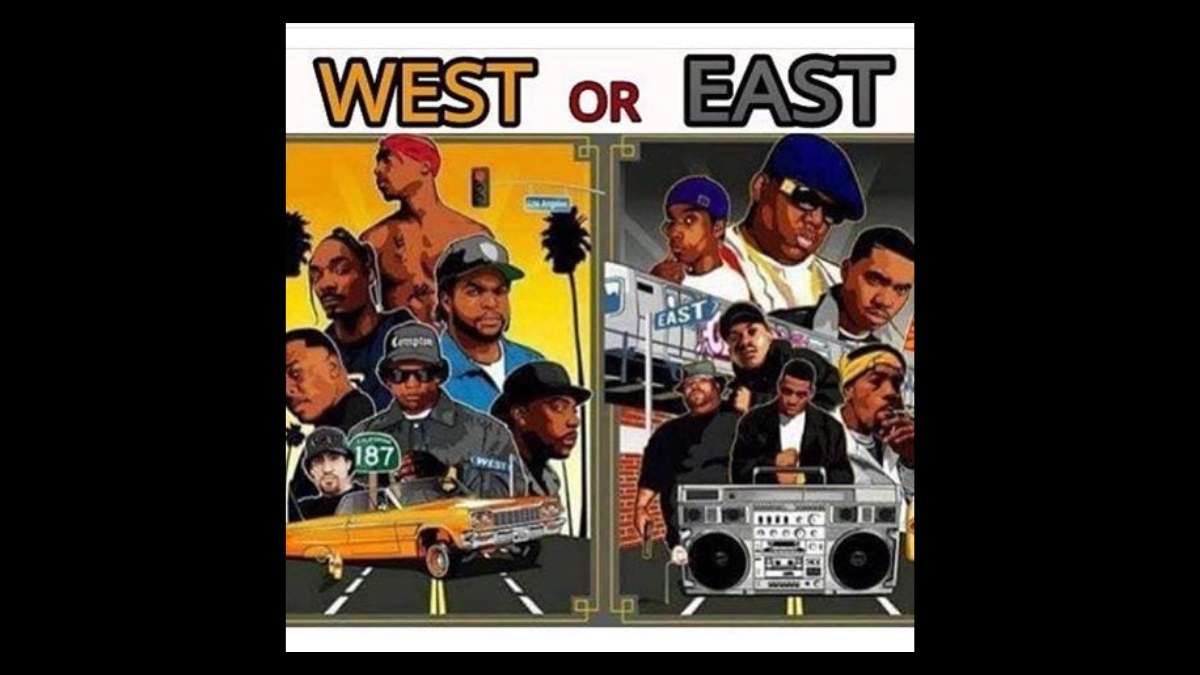Street Narratives: East Coast Storytelling vs. West Coast Realism

Hip-hop, as a genre, has long served as a powerful medium for storytelling, providing a voice to the voiceless and a lens into the realities of urban life. While both the East Coast and West Coast have made indelible contributions to the art of lyrical storytelling, their approaches to thematic content, narrative techniques, and personal experiences offer distinct flavours that reflect their unique cultural landscapes.
East Coast Storytelling: The Art of the Urban Tale
The East Coast, particularly New York City, is renowned for its dense, complex, and highly detailed lyrical narratives. East Coast rappers often employ intricate wordplay, metaphors, and multisyllabic rhymes to craft their stories, making the lyrical content as much a work of poetry as it is a musical expression.
Storytelling Techniques:
East Coast rappers are known for their ability to weave vivid, cinematic tales that capture the gritty reality of urban life. Artists like Nas, with his seminal album ‘Illmatic,’ exemplify this approach. In tracks like ‘NY State of Mind,’ Nas paints a picture of life in the Queensbridge projects, using detailed imagery and a first-person perspective to draw listeners into his world.
The narrative style often includes complex characters, plot twists, and moral reflections, making the songs resemble short stories or urban epics. The focus is not just on the events themselves but on the emotional and psychological experiences of the individuals involved.
Thematic Content:
Themes of survival, struggle, and social justice are prevalent in East Coast rap. The lyrics frequently address issues such as poverty, crime, systemic racism, and the resilience of marginalized communities. For example, in ‘The Message’ by Grandmaster Flash and the Furious Five, the stark realities of inner-city life are laid bare, highlighting the socio-economic challenges faced by many African Americans.
Social commentary is a hallmark of East Coast lyricism, with rappers using their platform to critique societal injustices and advocate for change. This tradition of socially conscious rap has influenced generations of artists, cementing the East Coast’s reputation for intellectual and reflective hip-hop.
West Coast Realism: The Sounds of the Streets
While the East Coast is known for its intricate storytelling, the West Coast has carved out its niche with a style that blends realism with a laid-back, yet raw, narrative approach. West Coast rappers often focus on direct, straightforward storytelling, capturing the essence of their environment with a sense of authenticity and immediacy.
Storytelling Techniques:
West Coast lyricism is characterized by its candidness and vivid portrayal of street life. Artists like Tupac Shakur exemplify this style, with songs like ‘Keep Ya Head Up’ and ‘California Love’ reflecting both the hardships and the celebratory aspects of West Coast culture. Tupac’s ability to convey raw emotion and personal experiences made his narratives deeply relatable and impactful.
The narrative style on the West Coast often includes a blend of autobiographical elements and broader social observations. The use of dialogue, conversational tones, and realistic scenarios helps to create a sense of immersion, making listeners feel as though they are part of the story.
Thematic Content:
Themes of gang culture, police brutality, and racial inequality are prevalent in West Coast rap. The lyrics often reflect the realities of life in neighbourhoods plagued by violence and poverty, providing a stark commentary on the socio-political issues of the time. N.W.A’s ‘Straight Outta Compton’ is a quintessential example, offering a raw and unfiltered look at life in South Central Los Angeles.
West Coast rap also frequently celebrates the region’s culture, from its car culture to its distinctive slang and fashion. This duality of highlighting both the struggles and the unique aspects of West Coast life gives the music a multifaceted appeal.
Personal Experiences and Cultural Reflection
Both East Coast and West Coast rap are deeply rooted in the personal experiences of the artists, reflecting their individual journeys and the broader cultural contexts in which they exist. However, the way these experiences are expressed differs significantly.
East Coast:
East Coast rappers often delve into the complexities of their personal lives, exploring themes of introspection, identity, and existential struggle. The lyrical content is frequently introspective, with a focus on the internal battles and moral dilemmas faced by the artist. Jay-Z, in tracks like ‘Regrets’ and ‘Can I Live,’ provides a nuanced look at the sacrifices and consequences of his rise to success.
West Coast:
In contrast, West Coast rappers tend to emphasize external realities, using their personal experiences to comment on broader social issues. The lyrics are often direct and unvarnished, with a focus on survival and resilience in the face of adversity. Snoop Dogg’s ‘Gin and Juice’ and Dr. Dre’s ‘Nuthin’ but a ‘G’ Thang’ capture the lifestyle and ethos of West Coast living, blending personal narrative with cultural commentary.
The contrast between East Coast and West Coast rap highlights the diversity and richness of hip-hop as a genre. East Coast storytelling, with its intricate lyricism and deep social commentary, offers a reflective and intellectual take on urban life. West Coast realism, with its raw, straightforward narratives and cultural celebration, provides an unfiltered look at the streets.
Together, these styles showcase the power of hip-hop to convey complex human experiences and societal issues through compelling and varied lyrical approaches. The ongoing dialogue between these coasts continues to push the boundaries of what hip-hop can express, making it a dynamic and ever-evolving art form.
Also Read: The Birth of Hip-Hop: East Coast Roots vs. West Coast Evolution
—Silviya.Y








